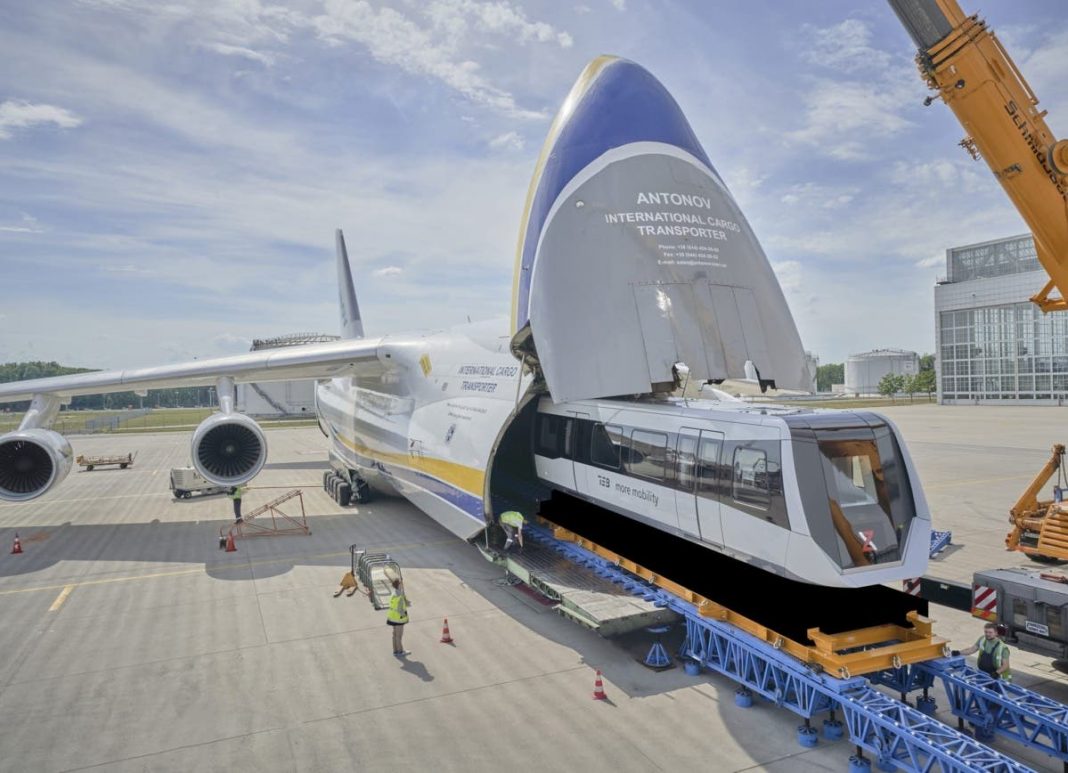A groundbreaking train has taken to the skies, but perhaps not in the way you were hoping. The friction-free maglev train, built by German company Max Boegl, has been flown more than 7,500 km from Munich to Chengdu, aboard the inimitable Antonov AN-124 aircraft.

Moving a train on one of the world’s largest planes
When you’ve got something as big as an urban maglev train to move halfway around the world, you need a big plane to get the job done. Naturally, the choice has to be Antonov Airlines of Ukraine, and their colossal AN-124-100, one of the biggest cargo planes in the sky.
Stay informed: Sign up for our daily aviation news digest.
The Max Boegl Group sent the first two section vehicle of its Transport System Boegl train from Munich to Chengdu in China last month. The flight was over 7,500 km and was easily conducted by the beautiful AN-124 aircraft.

The trains, weighing 36 tons, measured over 12 meters long each. As such, special transportation methods had to be developed by Antonov Airlines to keep them safe during the journey. Andriy Blagovisniy, commercial director of Antonov Airlines, told Air Cargo News about the mission, saying,
“For Antonov Airlines, this project was both challenging and interesting at the same time. Its realization required careful preparation and performance of the flight strictly in accordance with the confirmed schedule. We thank our customer, KN Airlift, for their continued trust and effective cooperation.”
Transporting the first maglev
This first production version of the Max Boegl Group’s maglev vehicle is not just interesting for the fact it’s flown further than most passengers have in the last few months. It is also a groundbreaking piece of kit, set to improve urban mobility in the Chengu area.
The two-car unit will be used on a 3.5 km rail, which was designed and built by Max Boegl in partnership with Xinzhu, as a means of demonstrating the Transport System Boegl (TSB) in an urban situation.
TSB was originally born from the ashes of the German Transrapid maglev project. Once considered to be the future of urban connectivity in Germany, the project only got as far as a short test track near Nurnberg, which really only allowed the company to refine the product’s technology.

It was never rolled out in any German city, and as such, has been waiting for a new city to demonstrate its capabilities. The system promises to achieve mass rapid transportation in an easily deployable, comfortable product, with speeds of up to 160 km/h achievable on longer sections of guideway.
As a maglev train, it has zero contact between wheels and rails. This means it produces minimal vibrations and noise and requires only small substructures for the track. Give it a few years, and next time you’re in China, you might find yourself making your way around its busiest cities on this groundbreaking new train!
The perfect task for the AN-124
With an internal length of 36.5 m, the Antonov AN-124 is an ideal choice for moving special cargo, particularly trains. The airline has moved everything from locomotives to trams and various railway carriages.

In fact, back in June of 1994, the airline broke the world record for carrying the heaviest payload by air. That day, the Antonov shifted a locomotive weighing 109 tons from Ontario in Canada to Dublin in Ireland.
Other notable movements include the transportation of four Bombardier metro cars, the MOVIA series, from Germany to India. These are still in use today by the Delhi Metro Rail Corporation.

Of course, the huge Antonov air transporters carry much more than just trains and carriages. Over the years, they have been known for transporting everything from parts for planes to cars and even entire helicopters.
When Boeing struggled with the giant GenX engines for the Boeing 777X, Antonov transported the world’s biggest aircraft powerplants from Boeing’s Everett factory to GE Aviation in Ohio so they could be fixed.
The Antonov AN-125 is not the biggest of all transporters, of course. The AN-225 ‘Mriya’ is bigger. But it’s a superb massive load shifter that has proven to us once and for all, trains can indeed fly!
[ad_2]
Source link



